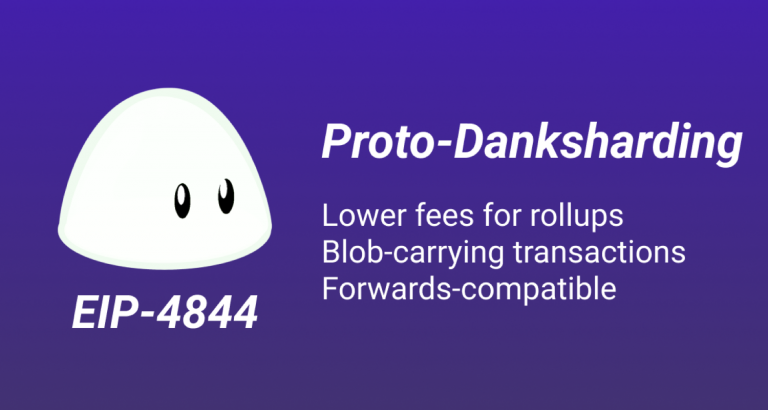坎昆升级在即,在L2和L1间如何做出投资选择?
ผู้เขียนต้นฉบับ: Revelo Intel
การรวบรวมต้นฉบับ: Deep Chao TechFlow
บทนำ: ทำความเข้าใจหลักการทางเศรษฐศาสตร์ของ Rollup
แผนงานความสามารถในการปรับขนาดของ Ethereum มุ่งเน้นไปที่โซลูชัน Rollup มากขึ้น และด้วยการนำไปใช้อย่างต่อเนื่องและ EIP-4844 ที่คาดการณ์ไว้ โซลูชัน Ethereum Layer 2 (L2) จึงได้รับความสำคัญอย่างยั่งยืน
อย่างไรก็ตาม การประเมินโซลูชัน L2 นั้นไม่ใช่เรื่องง่าย แตกต่างจากเครือข่าย L1 เช่น Ethereum ซึ่งมีแหล่งรายได้ที่ชัดเจนจากค่าธรรมเนียมการทำธุรกรรมและค่าธรรมเนียมที่ชัดเจนจากการออกโทเค็น โซลูชัน L2 ก่อให้เกิดความท้าทายในการประเมินมูลค่าที่ไม่เหมือนใคร
รายงานนี้สำรวจความซับซ้อนของการประเมินโซลูชัน Ethereum Layer 2 และให้ข้อมูลเชิงลึกเกี่ยวกับปัจจัยทางเศรษฐกิจที่สนับสนุนคุณค่าที่นำเสนอ
ภาพรวม
ความก้าวหน้าที่สำคัญในเทคโนโลยีที่โซลูชัน Rollup ได้ทำในช่วงไม่กี่ปีที่ผ่านมาไม่สามารถละเลยได้ นับตั้งแต่การถือกำเนิดของเทคโนโลยี Rollup ในปี 2018 ผู้ที่มีความสามารถและการลงทุนด้านการวิจัยจำนวนมากได้นำมาซึ่งความก้าวหน้าทางเทคโนโลยีที่สำคัญ รวมถึงการใช้งาน Rollup ที่เทียบเท่ากับ Ethereum Virtual Machine (EVM) การเชื่อมโยงเทคโนโลยีที่อิงกับการฉ้อโกงและหลักฐานความถูกต้อง และการบีบอัดข้อมูลแบบแบตช์ . ความก้าวหน้าและการเปิดตัว Rollup Software Development Kit (SDK) เป็นที่น่าสังเกตว่าโซลูชัน Rollup ต่างๆ เช่น Optimism, Arbitrum, Base, zkSync และ StarkNet ได้เข้าสู่ตลาดแล้ว โดยส่งเสริมการก่อตัวของระบบนิเวศที่เจริญรุ่งเรือง ปล่อยให้โซลูชันเลเยอร์ 1 อื่นๆ มีความเสี่ยงและถูกเปิดโปงในการต่อสู้เพื่อแย่งชิงตำแหน่งส่วนแบ่งตลาด
แม้ว่าอัตราการนำไปใช้ในปัจจุบันจะสอดคล้องกับความคาดหวังและแสดงให้เห็นถึงความเป็นไปได้ในการดึงดูดผู้ใช้รุ่นต่อไป แต่เส้นทางการเติบโตของโซลูชัน Layer 2 (L2) จะเพิ่มขึ้นอย่างรวดเร็วในอีกไม่กี่เดือนข้างหน้า ด้วยการมาถึงของ EIP-4844 ที่กำลังจะเกิดขึ้นและการเปิดตัวเชนใหม่ เช่น Scroll, Linea และ Base ทำให้ L2 กลายเป็นที่จับตามอง
EIP-4844: โครงสร้างต้นทุน
การอัพเกรด Dencun (Cancun) ที่กำลังจะมาถึงนั้นมาพร้อมกับคุณสมบัติที่สำคัญ - EIP-4844 หรือที่เรียกว่า Proto-Danksharding ซึ่งช่วยลดค่าใช้จ่ายในการดำเนินงานที่เกี่ยวข้องกับ Rollup ได้อย่างมาก ในขณะที่ข้อกำหนดเฉพาะสำหรับ Danksharding ยังคงพัฒนาต่อไป EIP-4844 ได้ปูทางสำหรับการเปลี่ยนแปลงที่ราบรื่นของสถาปัตยกรรมโปรโตคอล Ethereum เพื่อรองรับการใช้งาน Danksharding ในอนาคต
การใช้งาน Rollup ในปัจจุบันเผชิญกับความท้าทายที่สำคัญสองประการ ประการแรก เนื่องจาก L2 ประมวลผลธุรกรรมหลายล้านรายการทุกวัน รวมเข้าด้วยกันและส่งหลักฐานธุรกรรมไปยัง Ethereum จึงเกิดปัญหาคอขวดในการจัดเก็บข้อมูล ประการที่สอง มีค่าใช้จ่ายการทำธุรกรรมที่เกี่ยวข้องกับการส่งข้อมูลธุรกรรมจาก L2 ไปยัง Ethereum
หัวใจสำคัญของ EIP-4844 คือแนวคิดของ Blobs (วัตถุไบนารีขนาดใหญ่) โดยพื้นฐานแล้ว Blob คือกลุ่มข้อมูลที่เกี่ยวข้องกับธุรกรรม ซึ่งแตกต่างจากธุรกรรมปกติ Blob เหล่านี้ถูกจัดเก็บไว้บน Beacon Chain โดยเฉพาะ และต้องเสียค่าธรรมเนียมน้ำมันขั้นต่ำ อนุญาตให้บล็อก Ethereum เพิ่มข้อมูลโดยไม่ต้องเพิ่มขนาด พูดง่ายๆ ก็คือ การใช้ประโยชน์จาก Blob สามารถเพิ่มปริมาณข้อมูลที่จัดเก็บได้เกือบ 10 เท่า เมื่อเทียบกับขนาดบล็อกโดยเฉลี่ย
วัตถุประสงค์หลักของ Blob คือการลดค่าใช้จ่ายด้านความพร้อมใช้งานของข้อมูล (DA) ลงอย่างมาก โดยเฉพาะอย่างยิ่งสำหรับการเปิดตัว L1 ของ Rollup แตกต่างจากวิธีการแบบดั้งเดิมที่ข้อมูล Rollup ทั้งหมดถูกจัดเก็บไว้ในพื้นที่ calldata ของ Ethereum blobs มอบทางเลือกที่มีประสิทธิภาพและคุ้มค่า เนื่องจากเลเยอร์ฉันทามติจัดการพื้นที่เก็บข้อมูล Blob ธุรกรรม Blob จึงไม่มีข้อกำหนดเพิ่มเติมเกี่ยวกับเครื่องมือตรวจสอบ นอกจากนี้ ข้อมูล Blob จะถูกลบโดยอัตโนมัติภายใน 30 ถึง 60 วันที่แนะนำ ซึ่งสอดคล้องกับเป้าหมายของ Ethereum ในการแสวงหาความสามารถในการขยายขนาด แทนที่จะจัดเก็บข้อมูลแบบไม่มีกำหนด

ก่อนการใช้งาน EIP-4844 ค่าใช้จ่ายในการเผยแพร่ L1 คิดเป็นสัดส่วนมากกว่า 90% ของค่าใช้จ่ายโดยรวม นับจากนี้ไป EIP-4844 ขอแนะนำแนวคิด data gas ซึ่งเป็นหมวดหมู่ค่าธรรมเนียมใหม่สำหรับธุรกรรม Blob ซึ่งจะแยกต้นทุนในการเผยแพร่ข้อมูล L2 ไปยัง Ethereum ออกจากราคาก๊าซมาตรฐาน ด้วยการกำหนดราคาแบบไดนามิกตามอุปสงค์และอุปทานหยด L2 สามารถลดต้นทุนได้อย่างมากเมื่อส่งข้อมูลไปยัง Ethereum โดยอาจลดต้นทุนได้มากถึง 16 เท่าหรือ 90% ของค่าธรรมเนียมก๊าซในปัจจุบัน
Blobs เป็นเหมือนบล็อกข้อมูลที่ทำให้ Ethereum ทำงานได้อย่างมีประสิทธิภาพมากขึ้น โดยจะถูกจัดเก็บแยกกัน ไม่รบกวนเครื่องมือตรวจสอบความถูกต้อง และหายไปเมื่อไม่ต้องการอีกต่อไป นี่หมายถึงต้นทุนที่ลดลงและพื้นที่สำหรับข้อมูลมากขึ้น ทำให้ Ethereum เร็วขึ้นและถูกลง
เศรษฐศาสตร์ของการโรลอัพ
เพื่อให้เข้าใจถึงความสำคัญของ EIP-4844 สิ่งสำคัญคือต้องเข้าใจโมเดลธุรกิจของ Rollup การอัปเกรดส่งผลให้ต้นทุนลดลงอย่างมาก ในขณะที่ความคาดหวังด้านรายได้มีแนวโน้มที่จะยังคงมีเสถียรภาพหรือเพิ่มขึ้นเมื่อกิจกรรมออนไลน์เพิ่มขึ้น
เพื่อให้เข้าใจถึงผลกระทบของ EIP-4844 ต่อแบบจำลองเศรษฐกิจ Rollup อย่างถ่องแท้ จะต้องวิเคราะห์แหล่งที่มาของรายได้อย่างละเอียด Rollup สร้างรายได้จากค่าธรรมเนียมเครือข่ายและ Miner Extractable Value (MEV) ปัจจุบัน ทุน MEV ถูกควบคุมโดย Sequencer แบบรวมศูนย์ที่ผูกขาด MEV
ในแง่ของต้นทุน Rollup ต้องเผชิญกับค่าใช้จ่ายคงที่และค่าใช้จ่ายผันแปร ต้นทุนคงที่มาจากการดำเนินงาน เช่น การเผยแพร่รากสถานะไปยังสัญญาอัจฉริยะ Rollup การพิสูจน์ความถูกต้องสำหรับ ZK Rollup และค่าธรรมเนียมการทำธุรกรรมพื้นฐานบน Ethereum ต้นทุนผันแปร ได้แก่ ค่าธรรมเนียมก๊าซ L2 และค่าธรรมเนียมการออก L1 ที่จำเป็นในการจัดเก็บข้อมูลจำนวนมากลงใน Ethereum
EIP-4844 นำเสนอระบบค่าธรรมเนียม Blob แบบไดนามิก ซึ่งค่าธรรมเนียมจะพิจารณาจากอุปสงค์และอุปทานของ Blob โดยไม่ขึ้นอยู่กับข้อกำหนดของพื้นที่บล็อก ซึ่งแตกต่างจากรูปแบบค่าธรรมเนียมแบบดั้งเดิม ดังนั้นตลาดค่าธรรมเนียมของ Ethereum หลังจาก EIP-4844 จึงมีสองมิติ:
ตลาดค่าธรรมเนียมการทำธุรกรรมปกติตาม EIP-1559: มิติข้อมูลนี้ยังคงรักษาตลาดค่าธรรมเนียม EIP-1559 ที่มีอยู่สำหรับการทำธุรกรรมปกติ โดยมีไดนามิกเฉพาะ รวมถึงค่าธรรมเนียมพื้นฐานและค่าธรรมเนียมลำดับความสำคัญที่สอดคล้องกับหลักการ EIP-1559
ตลาดค่าธรรมเนียม Blob: มิติที่สองแนะนำตลาดค่าธรรมเนียม Blob โดยที่ค่าธรรมเนียมจะถูกกำหนดโดยอุปสงค์และอุปทานของ Blob ในปัจจุบัน สิ่งนี้จะสร้างระบบนิเวศที่แยกจากตลาดค่าธรรมเนียมการทำธุรกรรมปกติ เพื่อให้มั่นใจว่าค่าธรรมเนียม blob จะไม่ได้รับผลกระทบจากความผันผวนของความต้องการพื้นที่บล็อค
การวิเคราะห์ตลาดค่าธรรมเนียม EIP-4844 เผยผลลัพธ์ที่น่าสังเกตหลายประการ:
เมื่อจำนวนเครือข่ายแอปพลิเคชันและ L2 ทั่วไปเพิ่มขึ้น ความต้องการ Blob ก็คาดว่าจะค่อยๆ เพิ่มขึ้น กลไกการค้นหาราคาของ EIP-4844 อาจทำให้ราคาก๊าซข้อมูลเพิ่มขึ้นในสถานการณ์ที่ความต้องการเกินเป้าหมายหยด
ต้นทุนก๊าซข้อมูลคาดว่าจะเพิ่มขึ้นแบบทวีคูณตามความต้องการที่เพิ่มขึ้น หากความต้องการ Blob เกินระดับเป้าหมาย ต้นทุนของ Data Gas จะเพิ่มขึ้นอย่างรวดเร็วและทวีคูณ ซึ่งอาจมากกว่า 10 เท่าในเวลาไม่กี่ชั่วโมง เมื่อความต้องการหยดถึงราคาเป้าหมาย ราคาก๊าซข้อมูลจะเพิ่มขึ้นแบบทวีคูณทุกๆ 12 วินาที
EIP-4844 เปลี่ยนวิธีที่ Rollup ทำและใช้จ่ายเงิน ด้วยค่าธรรมเนียม Blob แบบไดนามิก ส่วนหนึ่งของตลาดค่าธรรมเนียมจะเป็นไปตามกฎปกติ ในขณะที่อีกส่วนหนึ่งจะปรับตามอุปสงค์และอุปทานของ Blob เมื่อความต้องการหยดเพิ่มขึ้น ต้นทุนก๊าซก็เพิ่มขึ้นเช่นกัน
Rollups as a Service
เมื่อจำนวนกลุ่มแอปพลิเคชันเฉพาะเพิ่มขึ้น โมเดลธุรกิจ Rollups as a Service (RaaS) จึงมีความสำคัญมากขึ้น ตัวอย่างเช่น Ethereum Layer 2 มีข้อได้เปรียบที่ชัดเจนเหนือเครือข่ายเฉพาะแอปพลิเคชันบนแพลตฟอร์มอย่าง Cosmos ซึ่งส่วนใหญ่เกิดจากการเกิดขึ้นของโซลูชัน RaaS
เหตุผลสำคัญสำหรับข้อได้เปรียบนี้คือการลดค่าใช้จ่ายด้านโครงสร้างพื้นฐาน ในบริบทของ Ethereum Layer 2 กระบวนการนี้ง่ายขึ้นอย่างมากด้วยโซลูชัน RaaS บริการเหล่านี้ช่วยลดความยุ่งยากในการปรับใช้ การบำรุงรักษา และการจัดการ Rollups แบบกำหนดเอง แก้ปัญหาความซับซ้อนทางเทคนิคที่นักพัฒนามักพบเมื่อพัฒนาเมนเน็ตได้อย่างมีประสิทธิภาพ ดังนั้น RaaS ช่วยให้นักพัฒนามุ่งเน้นไปที่การพัฒนาเลเยอร์แอปพลิเคชัน และปรับปรุงประสิทธิภาพการทำงานโดยรวม
RaaS ยังมีการปรับแต่งในระดับที่สำคัญอีกด้วย นักพัฒนาไม่เพียงแต่สามารถเลือกสภาพแวดล้อมการดำเนินการ ชั้นการชำระบัญชี และโปรโตคอลชั้นความพร้อมใช้งานของข้อมูลที่ต้องการเท่านั้น แต่ยังได้รับความยืดหยุ่นในด้านสำคัญ เช่น โครงสร้างผู้สั่งซื้อ ค่าธรรมเนียมเครือข่าย เศรษฐศาสตร์โทเค็น และการออกแบบเครือข่ายโดยรวม ความสามารถในการปรับตัวนี้ช่วยให้มั่นใจได้ว่า RaaS สามารถปรับแต่งได้ตามความต้องการและเป้าหมายเฉพาะของโครงการต่างๆ ที่หลากหลาย ซึ่งจะช่วยเพิ่มความคล่องตัวของโซลูชันชั้นสองของ Ethereum
เราสามารถแยกแยะบริการหลักได้สองประเภท:
SDK (ชุดพัฒนาซอฟต์แวร์): เหล่านี้เป็นเฟรมเวิร์กการพัฒนาที่ใช้งานเป็นชุดรวม รวมถึงตัวเลือกที่รู้จักกันดี เช่น OP Stack, Arbitrum Orbit สำหรับ L3s, Celestia Rollkit และ Dymension RollApp Development Kit (RDK)
บริการปรับใช้ Codeless Rollup: เพื่อทำให้การออกแบบง่ายขึ้น บริการเหล่านี้ช่วยให้สามารถใช้งาน Rollups ได้โดยไม่ต้องมีความรู้ด้านการเขียนโค้ดในเชิงลึก โซลูชันต่างๆ เช่น Eclipse, Cartesi, Constellation, Alt Layer, Saga และ Conduit อยู่ในหมวดหมู่นี้ พวกเขาลดอุปสรรคสำหรับนักพัฒนาและองค์กรในการใช้ประโยชน์จากเทคโนโลยี Rollup
นอกจากนี้เรายังอาจรวมหมวดหมู่ที่สามสำหรับชุดซีเควนเซอร์ที่ใช้ร่วมกันซึ่งให้บริการโรลอัปหลายรายการพร้อมกัน เช่น Suave หรือ Espresso ของ Flashbots
แม้ว่าภาพรวมของตลาดในปัจจุบันจะแสดงความต้องการเพียงเล็กน้อยสำหรับการสร้าง Rollup แบบกำหนดเอง แต่ก็มีความคาดหวังอย่างกว้างขวางว่า RaaS อาจเป็นแรงบันดาลใจให้เกิดการ Rollup หลายร้อยถึงหลายพันรายการ เนื่องจากสภาวะเศรษฐกิจมหภาคดีขึ้น และความเหมาะสมกับตลาดผลิตภัณฑ์มีความชัดเจนมากขึ้น
RaaS ทำให้ชีวิตของนักพัฒนาง่ายขึ้น เร็วขึ้น และยืดหยุ่นมากขึ้น สิ่งนี้ทำให้พวกเขามีเวลามากขึ้นในการจัดลำดับความสำคัญและมุ่งเน้นไปที่ตรรกะหลักและรูปแบบธุรกิจของแอปพลิเคชัน
ตั้งคำถามถึงประโยชน์ของโทเค็น L2
ความสำเร็จของโซลูชัน Rollup เช่น Optimism, Arbitrum, Mantle, zkSync ฯลฯ เป็นเรื่องที่ไม่ต้องสงสัย อย่างไรก็ตาม เมื่อพิจารณาจากโทเค็นการกำกับดูแล Rollup เช่น $OP หรือ $ARB จากมุมมองการลงทุน สถานการณ์จะซับซ้อนมากขึ้น
ตลาดหมี: กลับหัวมีจำกัด
ในตลาดการเงินแบบดั้งเดิม ผู้ถือหุ้นจะได้รับสิทธิต่างๆ มากมาย รวมถึงการจ่ายเงินปันผล สิทธิในการออกเสียง และการเรียกร้องในสินทรัพย์ ซึ่งทำให้หุ้นมีมูลค่าที่แท้จริงและทำให้เป็นการลงทุนที่น่าดึงดูด ในทางตรงกันข้าม โทเค็นที่เป็นตัวแทนของอำนาจการกำกับดูแลเท่านั้นขาดการรับประกันเหล่านี้ และจำกัดอยู่เพียงการลงคะแนนในข้อเสนอการกำกับดูแล เนื่องจากรายได้จาก Sequencer ที่เกิดจากค่าธรรมเนียมการทำธุรกรรมจะไม่ไหลไปสู่ผู้ถือโทเค็น การเติบโตของเครือข่ายจึงไม่ได้แปลเป็นมูลค่าโทเค็นที่เพิ่มขึ้นเสมอไป สิ่งนี้ทำให้เกิดคำถามที่ถูกต้องเกี่ยวกับข้อเสนอมูลค่าโทเค็นสะสม
ในขณะที่สิทธิ์ในการกำกับดูแลมีคุณค่าโดยธรรมชาติ โดยเฉพาะอย่างยิ่งในโซลูชันชั้นสองที่ผู้ถือโทเค็นมีอิทธิพลอย่างมาก (ดังที่เห็นใน RPGF ของ Optimism และ STIP ของ Arbitrum) การขาดเงินปันผลหรือแหล่งรายได้อื่น ๆ ทำให้พวกเขามีรูปแบบการลงทุนที่แตกต่างกัน
ในสภาพแวดล้อมที่มีอัตราดอกเบี้ยสูงในปัจจุบัน สินทรัพย์ที่ไม่ได้ให้รายได้ที่แท้จริงอาจไม่น่าดึงดูดสำหรับนักลงทุนแบบอนุรักษ์นิยม อัตราดอกเบี้ยที่สูงขึ้นทำให้ต้นทุนเงินทุนเพิ่มขึ้น ทำให้ต้นทุนเสียโอกาสในการถือครองสินทรัพย์ที่ไม่ก่อให้เกิดรายได้มีความสำคัญมากขึ้น เมื่อเทียบกับฉากหลังนี้ ETH ที่มีผลตอบแทนจากการปักหลักที่มั่นคงอาจเป็นทางเลือกที่ดีกว่าสำหรับนักลงทุนที่ไม่ชอบความเสี่ยง แม้ว่าโทเค็น Rollup จะมีศักยภาพในการเติบโตของก็ตาม
ตลาดกระทิง: เรื่องราวการเติบโต
ในตลาดการเงิน มูลค่าของบริษัทเชื่อมโยงกับมากกว่าผลกำไรหรือเงินปันผล ตัวอย่างเช่น หุ้นที่มีการเติบโตจะได้รับการประเมินมูลค่าตามศักยภาพในการเติบโตในระยะยาวและกลยุทธ์การลงทุนซ้ำ การลงทุนในโทเค็นการกำกับดูแลแบบ Rollup ก็อาจคล้ายคลึงกับการลงทุนในหุ้นที่มีการเติบโตแบบไม่มีเงินปันผล ในอดีต บริษัทอย่าง Amazon เลือกที่จะไม่จ่ายเงินปันผล แต่นำผลกำไรไปลงทุนใหม่เพื่อการขยายธุรกิจและนวัตกรรม ผู้ลงทุนในบริษัทดังกล่าวไม่จำเป็นต้องมองหาผลตอบแทนทันทีผ่านเงินปันผล แต่พวกเขาคาดหวังการเติบโตในระยะยาวและการแข็งค่าของมูลค่า ในกรณีของการมองโลกในแง่ดีและโทเค็น $OP มีความมุ่งมั่นที่ชัดเจนในการลงทุนผลกำไรใหม่ให้กับการเติบโตของระบบนิเวศ โดยส่งเสริมวงจรที่ดีของความต้องการที่เพิ่มขึ้นสำหรับ dApps ดั้งเดิม รายได้จากซีเควนเซอร์ และ RPGF นอกจากนี้ ด้วยความคิดริเริ่มเช่น Superchain บนขอบฟ้า แบนด์วิดท์ของ OP Stack ยังคงขยายตัวอย่างต่อเนื่อง ซึ่งท้ายที่สุดก็สร้างคูน้ำที่แข็งแกร่งซึ่งยากต่อการเพิกเฉยเนื่องจากผลกระทบของเครือข่าย
แนวโน้มอุตสาหกรรม
L2 กำลังพัฒนาไปสู่พื้นที่ที่มีการแข่งขันสูง และความคาดหวังโดยนัยของ airdrops อาจส่งผลกระทบอย่างมากต่อพฤติกรรมของผู้ใช้ภายใน L2 ที่กำหนด อย่างไรก็ตาม สิ่งสำคัญคือต้องรับรู้ว่าการประเมินมูลค่าของ L2 โดยเฉพาะนั้นเชื่อมโยงภายในกับมูลค่าของ L1 โดยผลกระทบจากเครือข่ายเป็นปัจจัยที่สร้างความแตกต่าง
การเชื่อมต่อนี้จะปรากฏชัดเจนเมื่อเราตรวจสอบการดำเนินการปัจจุบันของชุดรวมอัปเดต พวกเขาเรียกเก็บค่าธรรมเนียมก๊าซใน ETH และต้องชำระค่าธรรมเนียมความพร้อมใช้งานข้อมูลให้กับ Ethereum ใน ETH โดยพื้นฐานแล้ว การยกเลิกเหล่านี้ไม่สามารถบังคับใช้นโยบายการเงินของตนเองได้ Ethereum กำหนดจำนวนเงินที่พวกเขาต้องจ่ายให้กับห่วงโซ่พื้นฐาน
ดังนั้นจึงไม่มีเบี้ยประกันภัยทางการเงินเฉพาะสำหรับ L2 ถึงกระนั้น วิธีการซื้อขายโทเค็น L2 ในปัจจุบันก็ไม่สอดคล้องกับความเป็นจริงนี้เสมอไป อย่างไรก็ตาม ตราบใดที่พวกเขาสามารถสร้างระบบนิเวศที่แข็งแกร่งและส่งเสริมผลกระทบของเครือข่าย L2 เหล่านี้ก็มีศักยภาพที่จะกลายเป็นหน่วยงานที่มีอำนาจอธิปไตยในอนาคต และตลาดอาจพยายามที่จะคาดการณ์และคว้าโอกาสนี้ไว้
Airdrops สามารถมีอิทธิพลต่อพฤติกรรมของผู้ใช้ได้อย่างแน่นอน แต่สิ่งสำคัญคือ: มูลค่าของ L2 เชื่อมโยงอย่างใกล้ชิดกับ Ethereum (L1) L2 เรียกเก็บเงินและจ่ายเป็น $ETH ดังนั้นพวกเขาจึงไม่มีกฎสกุลเงินของตัวเอง เมื่อเทียบกับฉากหลังนี้ รูปแบบการดำเนินงาน L2 ในปัจจุบันปรากฏชัดเจน: พวกเขาเรียกเก็บค่าธรรมเนียมจากผู้ใช้ปลายทางและเก็บค่าธรรมเนียมส่วนหนึ่งไว้เพื่อให้ครอบคลุมค่าใช้จ่ายในการชำระบัญชีของ Ethereum และต้นทุนความพร้อมของข้อมูล การเป็นเจ้าของโทเค็นการกำกับดูแลที่เกี่ยวข้องจะเทียบเท่ากับการถือครองส่วนหนึ่งของส่วนต่างกำไรที่สร้างโดย L2
สิ่งต่างๆ จะน่าสนใจยิ่งขึ้นเมื่อสามารถสร้างหลายอินสแตนซ์ได้ เช่นเดียวกับในกรณีของการมองโลกในแง่ดี ในสถานการณ์เหล่านี้ ความแตกต่างของกำไรที่สร้างโดยอินสแตนซ์เหล่านี้สามารถไหลกลับไปยังผู้ถือโทเค็นได้ ตัวอย่างเช่น Base จัดสรรค่าธรรมเนียม 10% ให้กับ Optimism
โมเดลนี้ปลดล็อกศักยภาพที่มากขึ้นสำหรับความสามารถในการปรับขนาดของสินทรัพย์ L2 โดยสร้างแบบอย่างในการแบ่งปันค่าธรรมเนียมบางส่วนกับเครือข่ายอื่นๆ ในรูปแบบข้อตกลงใบอนุญาตโดยนัย ไดนามิกนี้ไม่เพียงแต่เพิ่มความลึกให้กับระบบนิเวศ L2 เท่านั้น แต่ยังเสริมความแข็งแกร่งให้กับข้อเสนอมูลค่าของโทเค็น L2 ในขณะที่โทเค็นเหล่านั้นยังคงพัฒนาและปรับตัวภายใต้ภูมิทัศน์การแข่งขัน
สถานการณ์ปัจจุบัน
ปัจจุบัน Ethereum มีการซื้อขายที่ประมาณ 301.4 พันล้านดอลลาร์ และคาดว่ามูลค่าของมันจะเพิ่มขึ้นเมื่อมีการสะสมที่เพิ่มขึ้น นอกจากนี้ การเปิดตัว Rollup as a Service (RaaS) คาดว่าจะนำกระแส Rollups ทั่วไปและเฉพาะแอปพลิเคชันออกสู่ตลาด
แม้ว่าเราจะคาดหวังได้ว่าชั้นฐานจะมีมูลค่าเพิ่มขึ้น แต่โดยทั่วไป L2 ก็มีเบต้าที่สูงกว่าเมื่อเทียบกับ $ETH นอกจากนี้ นักลงทุนอาจมองว่าโทเค็นของตนเป็นการเดิมพันกับระบบนิเวศทั้งหมด เราขอแนะนำแนวทางนี้ด้วยความระมัดระวัง เนื่องจากเป็นเรื่องปกติที่แต่ละโครงการจะเปลี่ยนไปใช้ L2 ล่าสุดและเป็นที่นิยมมากที่สุดในช่วงเวลาใดก็ตาม
นอกจากนี้ L2 ยังอยู่ในตำแหน่งที่จะดึงดูดผู้ใช้ได้มากขึ้น ซึ่งจะเป็นการเพิ่มมูลค่าที่ไหลกลับไปยัง Ethereum การเปลี่ยนแปลงนี้อาจเป็นไปตามการกระจายอำนาจ-กฎหมาย แม้ว่าจะไม่เด่นชัดเท่าที่สังเกตได้จากการเดิมพันสภาพคล่องก็ตาม ดังนั้นจึงเป็นไปได้ที่ในทางกลับกัน ETH จะเป็นข้อมูลอ้างอิงที่นักลงทุนอาจเต็มใจที่จะถือมากกว่า เมื่อ L2 เข้าสู่ตลาดมากขึ้นและ dApps ก็แพร่กระจายไปยัง L2 หลายตัว ห่วงโซ่ในการเลือกผู้ชนะขั้นสูงสุดจึงซับซ้อนมากขึ้น ไม่ว่าใครคือผู้ชนะสูงสุด ผู้ถือ ETH และผู้ตรวจสอบความถูกต้องของ Ethereum จะได้รับประโยชน์จากกิจกรรมสะสมที่เพิ่มขึ้น
ทั้งหมดเลย:
มูลค่าของ Ethereum เพิ่มขึ้นพร้อมกับการเติบโตของเทคโนโลยี Rollup และ Rollup as a Service (RaaS) จะนำกระแส Rollup เข้าสู่ตลาด
ความผันผวนของ L2 นั้นแตกต่างจาก ETH และโครงการสามารถสลับระหว่าง L2 ได้อย่างรวดเร็ว
L2 จะดึงดูดผู้ใช้มากขึ้น ซึ่งเป็นประโยชน์ต่อผู้ถือ $ETH และผู้ตรวจสอบความถูกต้อง แต่การเลือกผู้ชนะกลายเป็นเรื่องยากใน L2
ท้ายที่สุดแล้ว การถือ ETH น่าจะเป็นทางออกที่ปลอดภัยที่สุด
เราต้องการโซลูชัน L1 ทางเลือกอื่นๆ หรือไม่
วันเวลาของ L1 ในฐานะการค้าแบบหมุนเวียนดูเหมือนจะเป็นอดีตไปแล้ว เนื่องจากโซลูชัน L2 จัดการกับความท้าทายด้านความสามารถในการปรับขนาดของ Ethereum ได้อย่างมีประสิทธิภาพ จึงเป็นสิ่งสำคัญที่จะต้องตั้งคำถามถึงคุณค่าของบล็อกเชน L1 อื่นๆ เช่น Near, Avalanche, Solana, Fantom เป็นต้น
ข้อแตกต่างที่สำคัญคือความง่ายในการเปิดใช้ Total Value Locked (TVL) L2 มีข้อได้เปรียบในเรื่องนี้เนื่องจากผู้ใช้และนักพัฒนาคุ้นเคยกับเครื่องมือบน Ethereum อยู่แล้ว พวกเขาเพียงแค่ต้องเชื่อมโยงสินทรัพย์เข้ากับห่วงโซ่ L2 เพื่อใช้ประโยชน์จากต้นทุนการทำธุรกรรมที่ลดลง โดยพื้นฐานแล้ว TVL ซึ่งเดิมอยู่บน Ethereum กำลังมองหาสภาพแวดล้อมการซื้อขายที่คุ้มต้นทุนมากขึ้น
อย่างไรก็ตาม สิ่งสำคัญคือต้องรับรู้ว่าโซลูชัน L1 อื่นๆ ยังคงให้บริการตามวัตถุประสงค์เฉพาะและนำเสนอคุณลักษณะเฉพาะที่อาจดึงดูดการใช้งานบางกรณี
ระบบนิเวศที่หลากหลาย: L1 อื่นๆ ได้ปลูกฝังระบบนิเวศของตนเอง ซึ่งบ่อยครั้งจะมีชุมชน โครงการ และนวัตกรรมที่แตกต่างกัน ระบบนิเวศเหล่านี้อาจตอบสนองความต้องการของตลาดหรืออุตสาหกรรมเฉพาะ
คุณสมบัติพิเศษ: L1 บางตัวจัดลำดับความสำคัญของคุณสมบัติ เช่น ปริมาณงานสูง เวลาแฝงต่ำ หรือกลไกที่เป็นเอกฉันท์เฉพาะ คุณสมบัติเหล่านี้อาจทำให้เหมาะสมกับแอปพลิเคชันบางอย่างมากขึ้น เช่น การซื้อขายหรือการเล่นเกมที่มีความถี่สูง
การกระจายความเสี่ยง: จากมุมมองของการลงทุน การกระจายการลงทุนไปยัง L1 ต่างๆ สามารถลดความเสี่ยงได้ แม้ว่า Ethereum จะยังคงมีความโดดเด่น แต่ L1 อื่นๆ อาจเสนอโอกาสในการกระจายความเสี่ยง ตัวอย่างเช่น การลงทุนใน Solana อาจเป็นหนทางในการต่อสู้กับการครอบงำของ EVM (Ethereum Virtual Machine) (ลองจินตนาการถึงช่องโหว่แบบ Zero-day ที่ค้นพบใน EVM)
L1 เหล่านั้นที่สามารถนำคุณค่าที่เป็นเอกลักษณ์มาสู่ระบบนิเวศ (เช่น Solana, Monad เป็นต้น) จะยังคงอยู่ การจัดหาโซ่ที่เข้ากันได้กับ EVM พร้อมค่าธรรมเนียมน้ำมันที่ถูกกว่านั้นไม่เพียงพออีกต่อไป สิ่งนี้อาจดูเหมือนชัดเจนในตอนนี้ แต่ในอดีตมีหลายกรณีที่เครือข่ายที่เข้ากันได้กับ EVM ซึ่งมีต้นทุนก๊าซต่ำกว่าถึงการประเมินมูลค่าที่สูงเกินจริง ตัวอย่างเช่น Moonriver ซึ่งเป็นเครือข่ายที่เข้ากันได้กับ EVM บน Kusama (เครือข่ายนกขมิ้นของ Polkadot) ซึ่งแตะระดับสูงสุดตลอดกาลที่ 494 ดอลลาร์ในไตรมาสที่ 4 ปี 2021 และตอนนี้ซื้อขายที่ 4 ดอลลาร์
ทั้งหมดเลย:
L2 ลดความจำเป็นในการทำธุรกรรมการหมุนเวียน L1 ในขณะที่บล็อกเชน L1 อื่นๆ ยังคงให้บริการตามวัตถุประสงค์เฉพาะ L2 มีข้อได้เปรียบในการล็อคมูลค่ารวม (TVL) เนื่องจากมีเครื่องมือที่คุ้นเคยและต้นทุนการทำธุรกรรมที่ต่ำกว่า
อย่างไรก็ตาม ระบบนิเวศที่หลากหลาย คุณลักษณะพิเศษ และความหลากหลายทำให้ L1 อื่นๆ ยังคงน่าสนใจสำหรับกรณีการใช้งานเฉพาะและการลดความเสี่ยง
L1 ที่รอดมาได้จะนำมาซึ่งคุณค่าที่ไม่เหมือนใครนอกเหนือจากความเข้ากันได้ของ EVM และค่าก๊าซที่ลดลง
ประเด็นที่สำคัญ
วิธีการประเมินแบบดั้งเดิมเหมาะสำหรับ L1 มากกว่า โดยมีค่าธรรมเนียมการทำธุรกรรมเป็นรายได้ และการออกโทเค็นเป็นค่าใช้จ่าย L2 ก่อให้เกิดความท้าทายในการประเมินมูลค่า
แม้ว่าสกุลเงินดิจิทัลและหุ้นจะมีโครงสร้างที่แตกต่างกัน แต่ตรรกะการลงทุนขั้นพื้นฐานยังคงมีผลบังคับใช้ การลงทุนในสินทรัพย์ที่มีศักยภาพในการเติบโตในระยะยาวอาจเป็นกลยุทธ์ที่น่าสนใจ
L2 ดำเนินการโดยการจับสเปรด ซึ่งเป็นแบบจำลองที่ได้รับการเสริมประสิทธิภาพเมื่อมีการสร้างข้อตกลงการแบ่งปันรายได้โดยนัยกับเครือข่ายอื่นๆ เช่น Base ที่จัดสรรค่าธรรมเนียม 10% ให้กับคลัง Optimism
ETH ถือได้ว่าเป็นสินทรัพย์ “ดัชนี” ในขณะที่ L2 ทำหน้าที่เหมือนกับ “การเลือกหุ้น” ส่วนตัว ไม่ว่า L2 ใดที่มีการใช้งานมากที่สุด ทั้งผู้ถือ ETH และผู้ตรวจสอบความถูกต้องของ Ethereum จะได้รับประโยชน์จากกิจกรรมสะสมที่เพิ่มขึ้น
สรุปแล้ว
วิธีหนึ่งในการดูสิ่งนี้ก็คือ EIP 4844 จะลดต้นทุนของ L2 ลงอย่างมาก ในขณะที่รายได้จะเพิ่มขึ้นเมื่อเวลาผ่านไป ความแตกต่างระหว่างทั้งสองคืออัตรากำไรของ L2 เหล่านี้ เมื่อช่องว่างนี้กว้างขึ้น มีแนวโน้มเพิ่มขึ้นที่พวกเขาตัดสินใจที่จะเริ่มแบ่งปันผลกำไรเหล่านั้นกับผู้ถือโทเค็น หากคุณยินดีที่จะรอให้ชิ้นส่วนต่างๆ ลงตัว การคิดถึงตรรกะนี้ล่วงหน้าถือเป็นแนวทางที่ดี
ในขณะที่เราสร้างแผนภูมิเส้นทางสำหรับอนาคตของโทเค็นการกำกับดูแล Rollup เช่น $OP หรือ $ARB เป็นที่ชัดเจนว่าพื้นที่นั้นพร้อมสำหรับการเปลี่ยนแปลง การเพิ่มขึ้นของ EIP 4844, ERC 4337 และการเกิดขึ้นของ RaaS (รวมถึง SDK และบริการการปรับใช้แบบไม่มีโค้ด) ถือเป็นการประกาศถึงกระแสของการนำ Rollup มาใช้
คลื่นแห่งการยอมรับนี้มีแนวโน้มที่จะเห็นการเพิ่มขึ้นของ Rollups นับพันหรืออาจถึงหมื่นด้วยซ้ำ อย่างไรก็ตาม นักลงทุนจะถูกแบ่งตามมูลค่าของโทเค็นการกำกับดูแลเหล่านี้ ในด้านหนึ่ง ความท้าทาย เช่น การขาดกลไกการจับมูลค่าแบบดั้งเดิม และผลกระทบของสภาพแวดล้อมที่มีอัตราดอกเบี้ยสูง อาจจำกัดข้อดีที่อาจเกิดขึ้นของโทเค็น Rollup ในทางกลับกัน นักลงทุนบางรายอาจเปรียบเทียบโทเค็นเหล่านี้กับหุ้นที่ไม่มีเงินปันผล เช่น Google, Amazon และ Tesla โดยตระหนักถึงศักยภาพในการประเมินมูลค่าที่สูงขึ้นเนื่องจากแนวโน้มการเติบโตในระยะยาว
เมื่อเราก้าวเข้าสู่พื้นที่ที่มีการแข่งขันมากขึ้น สิ่งสำคัญคือต้องยังคงปรับตัวได้ เนื่องจากมีการเปลี่ยนแปลงตลอดเวลาและคุณสมบัติเฉพาะของโทเค็นการกำกับดูแล Rollup



